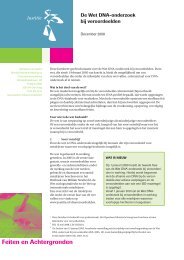INTERPOL HANDBOOK ON DNA DATA EXCHANGE AND PRACTICE
INTERPOL HANDBOOK ON DNA DATA EXCHANGE AND PRACTICE
INTERPOL HANDBOOK ON DNA DATA EXCHANGE AND PRACTICE
Create successful ePaper yourself
Turn your PDF publications into a flip-book with our unique Google optimized e-Paper software.
GEOGRAPHICAL SEARCH, PHYLOGENY,PHYSICAL CHARACTERISTICS<strong>AND</strong> OTHER USESThe information in the following section is not linked to the current use of forensic<strong>DNA</strong> Databases. It represents a future potential use of <strong>DNA</strong> that does not rely uponcomparison with collected profiles but where the <strong>DNA</strong> profile itself, obtained throughother genetic markers, may provide investigative support but does not lead to anidentification by itself.The present capacity of forensic <strong>DNA</strong> technology is impressive; however progressin molecular biology is increasing the range of genetic markers available for forensicpurposes. This has exciting potential for the use of forensic <strong>DNA</strong> results in investigations.Specific examples of this diversification include more widespread use of Y-chromosomeor mitochondrial <strong>DNA</strong> (mt<strong>DNA</strong>) markers (known as non-autosomal markers) or newmarker types such as single nucleotide polymorphisms (SNPs). These target regionsoffer the possibility to produce a <strong>DNA</strong> profile that indicates information about thebiogeographical ancestry of the donor, or information regarding certain personal orphysical characteristics.•geographic search, phylogenyThe mitochondrial genome and the non-recombining region of the Y chromosomerepresent the only two haploid regions of the human genome as both are transmitteduniparentally, with no recombination 24 . This lack of recombination means that theY chromosome and the mitochondrial variants show greater levels of geographicalaffiliation than profiles obtained through routine autosomal <strong>DNA</strong> testing.Refining applications for non-autosomal <strong>DNA</strong> profiling has been of considerable valueto the forensic field as it has increased the investigative relevance of the techniques andadded to the capability of casework laboratories. Mt<strong>DNA</strong> has been extensively usedin human evolution studies for a number of years 25 and is particularly suitable for thisapplication due primarily to the fact it is inherited down the maternal line (from motherto child). In forensic science mt<strong>DNA</strong> is most often analysed in circumstances whereroutine <strong>DNA</strong> tests fail to give a result. These commonly include the identification oftelogenic hairs 26 , nail material 27 and bone (associated with missing persons’ cases) 28 . Itis also used in cases where distant relatives are the only available source of referencematerial, such as in historic investigations or cold cases.GEOGRAPHICAL SEARCH, PHYLOGENY, PHYSICAL CHARACTERISTICS<strong>AND</strong> OTHER USESPAGE 77







